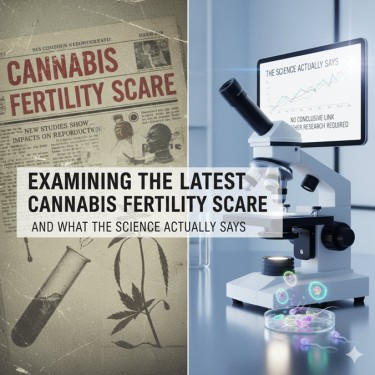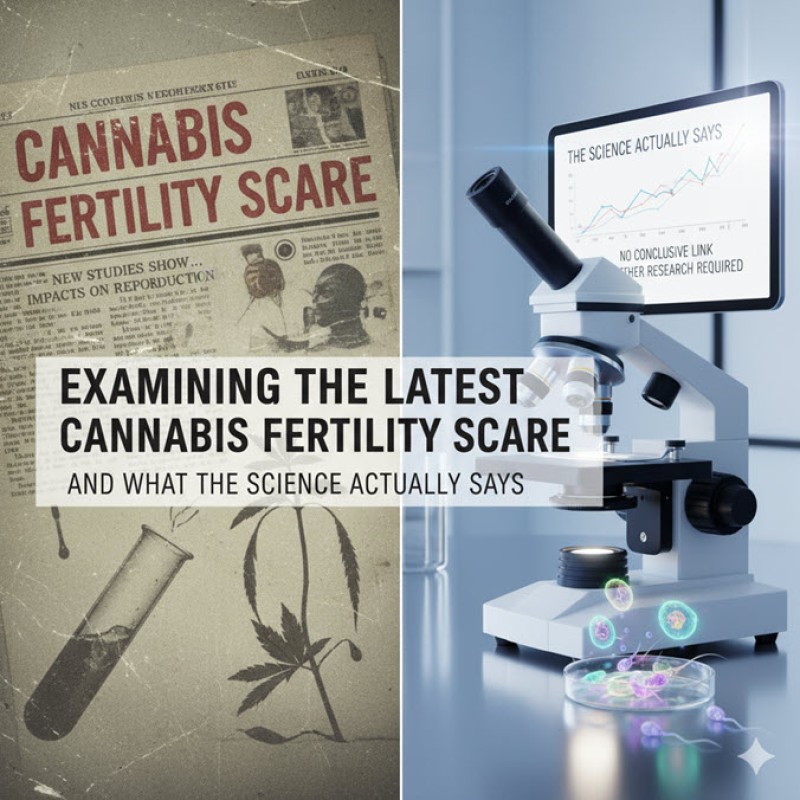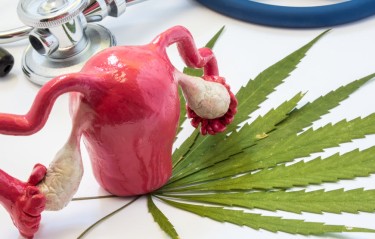
Here we go again. Just when you think we've moved past the era of sensationalized cannabis research designed to terrify the public, along comes another study that's being trumpeted as proof that marijuana is attacking our reproductive systems. CNN's headline screams "Marijuana may cause chromosomal defects in human egg cells," and suddenly social media is flooded with warnings about cannabis destroying fertility and creating genetic monsters.
But before we all panic and flush our stashes down the toilet, let's take a deep breath and examine what this study actually found – and more importantly, what it didn't find.
The research, published in Nature Communications, looked at over 1,000 ovarian fluid samples from patients undergoing infertility treatment and found some associations between THC levels and changes in egg maturation. The researchers are careful to note that their study "can only show an association and not a direct cause and effect," but somehow that crucial caveat gets lost in the media frenzy that follows.
This pattern should sound familiar to anyone who's been following cannabis research over the past few decades. Study finds correlation, media reports causation, public freaks out, and meanwhile the actual science gets buried under layers of speculation and fear-mongering. It's like a greatest hits compilation of marijuana moral panic, updated for the modern era.
Don't get me wrong – reproductive health is serious business, and any potential risks deserve careful investigation. But we also need to approach these findings with the same scientific skepticism we'd apply to any other research, especially when it comes to a plant that's been demonized for nearly a century.
The irony is rich: we're being told to worry about THC affecting fertility while millions of people in countries with high cannabis use – like Jamaica – continue having healthy babies at normal rates. If cannabis were truly the fertility destroyer these studies suggest, we'd expect to see clear population-level evidence of reproductive problems in places where cannabis use is widespread and culturally accepted.
So let's dig into this latest study, separate the science from the sensationalism, and see if there's actually cause for concern or if we're witnessing another case of correlation being dressed up as causation in the ongoing war on weed.
What the Study Actually Found (And What It Didn't)
Let's start with what the University of Toronto researchers actually did, because the methodology matters more than the scary headlines. They analyzed ovarian fluid samples from women undergoing fertility treatments – already a specialized population that may not represent typical cannabis users. They compared 62 patients who tested positive for THC with a control group and found some interesting associations.
The key findings were that women with detectable THC levels showed higher oocyte maturation rates and lower numbers of embryos with the correct chromosome count. In the lab portion of the study, immature eggs exposed to THC in petri dishes for 24 hours showed more altered spindles – structures that help chromosomes separate properly.
Now, here's where we need to put on our critical thinking caps. The researchers themselves acknowledge this is purely correlational data. Lead author Cyntia Duval specifically warned against panic, stating, "This is a hypothesis, and the worst thing I would want is for the public to read this and become fearful."
But there are several major limitations that should make us pause before drawing any dramatic conclusions. First, this study exclusively looked at women already experiencing fertility problems severe enough to require medical intervention. Using this population to make claims about general cannabis use and fertility is like studying people in cardiac intensive care units and concluding that breathing causes heart attacks.
Second, the study couldn't control for countless other variables that affect fertility and egg quality. What about stress levels, other drug use, diet, environmental toxins, age, underlying health conditions, or socioeconomic factors? Women seeking fertility treatment often have complex medical histories that could easily explain the observed differences.
Third, the lab portion of the study involved exposing eggs to THC in artificial conditions that bear little resemblance to how cannabis actually affects the human body. Soaking eggs in THC in a petri dish for 24 hours is about as relevant to real-world cannabis use as studying the effects of drowning cells in alcohol and claiming it proves drinking water is dangerous.
Perhaps most importantly, the study found associations with THC levels, but we have no idea about usage patterns, frequency, potency, or consumption methods. Were these occasional users or daily consumers? Did they use high-THC concentrates or low-potency flower? The study can't tell us.
The researchers also acknowledge they couldn't establish causation – a crucial limitation that seems to get lost in media coverage. Correlation and causation are not the same thing, and this distinction is fundamental to scientific literacy. Just because two things occur together doesn't mean one causes the other.
Furthermore, the clinical significance of the observed changes remains unclear. Even if THC does affect egg maturation in some way, we don't know whether these changes actually impact fertility outcomes or healthy pregnancies. The study didn't follow these women to see if THC exposure correlated with actual reproductive problems.
What we have is an interesting preliminary finding that raises questions worth investigating further. What we don't have is proof that cannabis use causes fertility problems or genetic defects – despite what the headlines might suggest.
The Jamaica Problem: When Real-World Evidence Contradicts Laboratory Fears
Here's where the cannabis fertility scare narrative runs into a massive real-world problem: if THC truly wreaks havoc on human reproduction, we should see clear evidence of this in populations with high cannabis use. Yet when we look at places like Jamaica, where cannabis use is deeply embedded in the culture and widely accepted, we don't see the reproductive catastrophe that laboratory studies seem to predict.
Jamaica has one of the highest rates of cannabis use in the world, with cultural acceptance spanning generations. If cannabis were truly causing significant chromosomal defects, fertility problems, or birth complications, we'd expect to see Jamaica struggling with abnormally high rates of genetic disorders, birth defects, or fertility issues. But that's simply not the case.
Jamaica's birth defect rates fall within normal global ranges. Their fertility rates are actually above global averages. Jamaican women have been using cannabis during pregnancy for generations – often as a traditional remedy for morning sickness – without the population-level reproductive disasters that these studies seem to suggest should be occurring.
This isn't to say that cannabis use during pregnancy is without risks or that it should be recommended. But the disconnect between laboratory findings and real-world outcomes in high-use populations suggests that either the risks are being overstated, or there are protective factors and adaptive mechanisms that laboratory studies can't capture.
Consider the broader context of reproductive health research. Birth defects occur in approximately 2-4% of all births globally, regardless of cannabis use. Major chromosomal abnormalities like Down syndrome occur in about 0.1-0.2% of births. If cannabis use were significantly increasing these rates, we'd see clear epidemiological evidence in populations with widespread use.
The Netherlands provides another interesting case study. Cannabis use is widely tolerated and relatively common, yet Dutch reproductive health statistics don't show the kind of fertility or birth defect epidemics that would be expected if these laboratory findings translated to real-world harm.
This pattern repeats across multiple populations with high cannabis use. From certain regions of India where cannabis has been used medicinally for centuries, to parts of Africa with traditional cannabis cultures, we simply don't see the reproductive health crises that laboratory studies seem to predict.
This doesn't mean we should ignore research or assume cannabis is completely harmless. But it does suggest that laboratory findings need to be interpreted within the context of real-world evidence. When in vitro studies contradict population-level data, we need to question whether the laboratory conditions accurately reflect how cannabis actually affects human health.
There's also the issue of publication bias and research funding priorities. Studies that find potential harms from cannabis often receive more attention and funding than studies that find no effects or beneficial effects. This can create a skewed perception of risk that doesn't align with actual population health data.
The scientific method requires that we consider all available evidence, not just the studies that confirm our preexisting beliefs or biases. When laboratory findings don't match real-world outcomes in high-use populations, that's not a reason to dismiss the research – it's a reason to dig deeper and ask better questions about what's really going on.
Science vs. Sensationalism: The Need for Balanced Cannabis Research
The latest cannabis fertility study represents both the promise and the pitfall of modern marijuana research. On one hand, we're finally getting sophisticated scientific analysis of how cannabis affects human biology. On the other hand, we're still struggling with sensationalized interpretations that often bear little resemblance to what the research actually shows.
The University of Toronto study raises legitimate questions worth investigating, but it doesn't provide the definitive answers that media coverage suggests. Correlation isn't causation, laboratory conditions don't replicate real-world use, and small studies of specialized populations can't support sweeping claims about general safety or risk.
What's most frustrating is how this pattern repeats: preliminary research gets amplified into scary headlines, nuanced scientific findings get reduced to simplistic warnings, and the actual complexity of cannabis effects on human health gets lost in the noise.
We need better cannabis research – studies that follow real-world users over time, research that accounts for the full complexity of human biology and behavior, and investigations that consider both potential harms and benefits. But we also need better science communication that doesn't turn every preliminary finding into a moral panic.
The real tragedy of sensationalized cannabis research isn't just that it scares people unnecessarily – it's that it undermines trust in legitimate scientific inquiry. When every study gets hyped as the definitive word on cannabis safety, people stop paying attention to research altogether.
Cannabis deserves the same rigorous, balanced scientific scrutiny we apply to any other health intervention. That means acknowledging both potential risks and benefits, recognizing the limitations of preliminary research, and always keeping real-world evidence in perspective.






